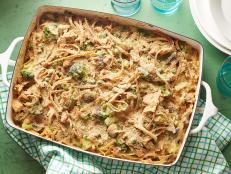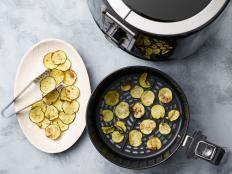What to Know About Healthy Eating During Menopause
Plus, whether or not weight gain during menopause is really unavoidable.

Arx0nt/Getty
The progression from perimenopause to post-menopause affects 6,000 women a day in the U.S. Lifestyle habits, including what you eat, can help counteract some of the issues commonly associated with menopause like weight gain, fatigue, changes in digestion, muscle loss, and osteoporosis. Healthful eating while your body is going through these hormonal changes can help ease the symptoms of menopause. Read on to learn more about how a few tweaks to your diet around, during and after menopause can make a difference.
What Is Menopause?
According to the Mayo Clinic, menopause marks the end of menstruation. During perimenopause and menopause, the female body experiences changing levels of hormones, which are chemical messengers in the body. Most tissues in the body (like the heart and brain) have estrogen receptors and estrogen decreases during menopause. When estrogen levels fluctuate and then drop, it leads to physical and psychological symptoms. Perimenopause usually occurs for most women in their 40s and can last for up to 10 years. During this time, many women experience changes in their menstrual cycle. Women are considered post-menopausal once they miss their period for 12 months in a row not due to causes like illness or pregnancy.
Why Eating Well During Menopause Is Important
“Nutrition is important during perimenopause and after menopause occurs because a decline in estrogen affects your health in many ways and nutrition helps to counteract those changes and help you feel your best for the rest of your life,” says Elizabeth Ward, MS, RDN, co-author, The Menopause Diet Plan, A Natural Guide to Hormones, Health, and Happiness. For example, lower estrogen levels increases the risk for osteoporosis (brittle bones), so it’s important to consume nutrients that support bone health like calcium, vitamin D, protein, magnesium, and potassium. During menopause, some women may also experience higher levels of bad cholesterol or LDL, which contributes to heart disease. As such, Ward recommends an eating pattern that is low in saturated fat and high in fiber.
Is Weight Gain During Menopause Inevitable?
“It's tough to say if perimenopause — the four to 10 years leading up to menopause and then post-menopause — are totally responsible for weight gain or if aging also plays a role,” Ward says. In their 40s and 50s, men tend to gain weight, so a woman’s weight gain is likely a combination of hormonal changes, less physical activity, a decline in muscle mass, and possibly a higher calorie intake than needed, says Ward. One difference? “Perimenopause weight gain favors the belly,” says Ward. “When women gain weight at this time of life, it typically goes to the abdominal area and that can be a big surprise for women who never gained weight there.”
How to Eat During Menopause
The Menopause Diet discusses five core principles for eating well during menopause. To find the best balance for your body, speak with a registered dietitian or medical professional to create an eating plan that works for you.
Eat according to your body clock. Our bodies are ruled by natural body rhythms that affect health, and when you eat matters. We suggest eating more of your calories at breakfast and lunch when the body is better at using them.
Focus on plant foods. Plant-rich eating plans typically supply a balance of healthy fats, fiber, vitamins, minerals, and phytonutrients that help reduce blood pressure and LDL cholesterol (“bad cholesterol”), lower the risk of type 2 diabetes, and promote a healthy weight. However, plant-rich eating plans can still include animal foods.
Curb carbohydrates and add more protein. Research suggests that many menopausal women do not consume the protein they need. Based on scientific evidence, The Menopause Diet includes more protein than is typically suggested for women over 50 and fewer carbohydrates.
Control calories. As our metabolism slows with age, we need to think about how to balance calories in the long run. If you want weight loss, you will need to create a calorie deficit. However, that doesn't mean you have to count every calorie.
Physical activity. Regular (near daily) physical activity helps you maintain muscle and bone, reduces type 2 diabetes and cancer risk, lowers stress, and so much more. Experts suggest a combination of aerobic exercise and strength training.
Ward shared a recipe from her book The Menopause Diet Plan. You can whip up this stir-fry using beef, chicken, tofu, or shrimp — you decide.

From The Menopause Diet Plan, A Natural Guide to Hormones, Health, and Happiness. Photo courtesy of Elizabeth Ward, MS, RDN
Stir-Fry, Your Way
Serves 4
Ingredients:
- 3⁄4 cup 100% orange juice
- 3 tablespoons reduced-sodium soy sauce
- 3 tablespoons rice vinegar
- 4 large garlic cloves, minced
- 2 teaspoons peeled, minced fresh ginger
- 1⁄4 cup cornstarch
- 2 tablespoons canola oil
- 1 pound shelled and deveined raw shrimp; or 1 pound boneless top round steak, trimmed of fat and sliced into 1⁄4 by 1-inch pieces; or 1 pound boneless, skinless chicken breast, cut into 1⁄2-inch cubes; or 1 (14-ounce) package extra-firm tofu, drained and cut into 1-inch cubes
- 5 cups chopped vegetables (such as red, green, and orange bell peppers; sugar snap peas; broccoli florets; sliced carrots)
Directions:
- In a small mixing bowl, combine the orange juice, soy sauce, vinegar, garlic, ginger, and cornstarch.
- Heat 1 tablespoon of the oil in a large skillet over medium-high heat. Add the shrimp, steak, or chicken, and cook until the shrimp is opaque, steak is medium rare, or chicken is cooked through, about 5 minutes. (Don’t add tofu until the very end.) Transfer the shrimp, steak, or chicken to a plate and cover to keep warm.
- Add the remaining tablespoon oil to the skillet. Add the vegetables and sauté over medium-high heat for 3 to 4 minutes, or until they are crisp-tender.
- Add the orange juice mixture to the pan and continue to cook the vegetables until they are fork-tender, stirring constantly, an- other 3 to 4 minutes. Stir the shrimp, steak, or chicken into the pan and toss with the vegetables to heat through for about 1 more minute. If using tofu instead, add it now, tossing to com- bine, cover, and cook for 2 minutes, or until heated through.
Per serving (with shrimp): Calories: 286 Carbohydrate: 24 grams; Dietary fiber: 4 grams; Total fat: 8 grams Saturated fat: 1 gram Cholesterol: 214 milligrams Protein: 31 grams Sodium: 595 milligrams Calcium: 124 milligrams Added sugar: 0 grams
Per serving (with beef): Calories: 356; Carbohydrate: 24 grams; Dietary fiber: 4 grams Total fat: 13 grams; Saturated fat: 3 grams Cholesterol: 87 milligrams Protein: 38 grams; Sodium: 545 milligrams Calcium: 63 milligrams Added sugar: 0 grams
Per serving (with chicken): Calories: 321; Carbohydrate: 24 grams Dietary fiber: 4 grams Total fat: 9 grams Saturated fat: 1 gram; Cholesterol: 87 milligrams Protein: 36 grams Sodium: 570 milligrams Calcium: 45 milligrams Added sugar: 0 grams
Per serving (with tofu): Calories: 284; Carbohydrate: 26 grams Dietary fiber: 5 grams Total fat: 14 grams Saturated fat: 2 grams; Cholesterol: 0 milligrams Protein: 17 grams Sodium: 475 milligrams Calcium: 417 milligrams Added sugar: 0 grams
Recipe from The Menopause Diet Plan, A Natural Guide to Hormones, Health, and Happiness. Photo courtesy of Elizabeth Ward, MS, RDN
*This article was written and/or reviewed by an independent registered dietitian nutritionist.
Toby Amidor, MS, RD, CDN, is a registered dietitian and consultant who specializes in food safety and culinary nutrition. She is the author of The Greek Yogurt Kitchen: More Than 130 Delicious, Healthy Recipes for Every Meal of the Day.
Related Links:

































